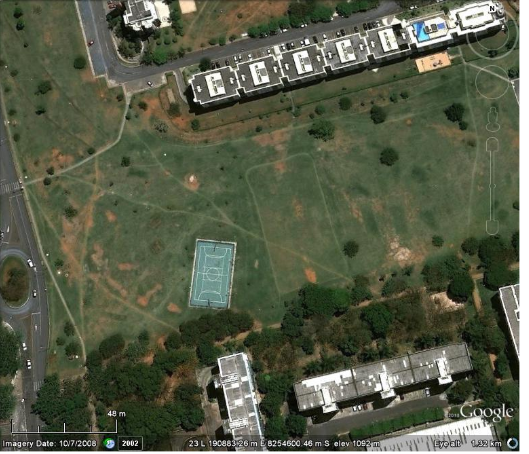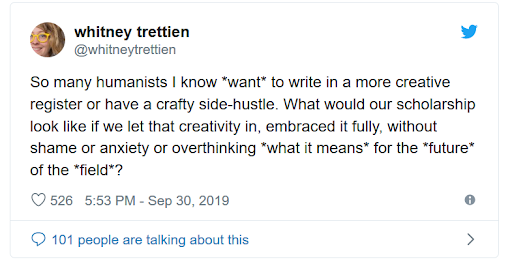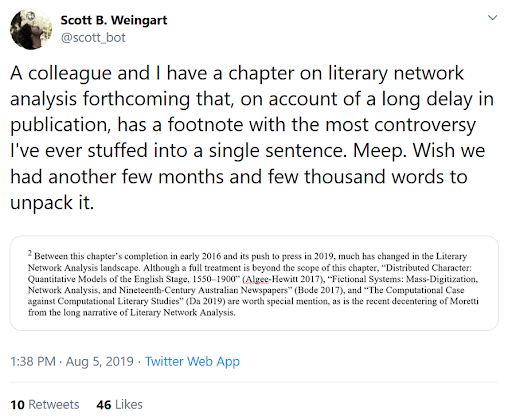By Erzsébet Tóth-Czifra
Walking the cities of the world, we can see two types of urban landscape. The first one is structured by pavements complemented by community-beaten, unpaved tracks that residents are actually using to reach their goals. In the second type, there is no such disharmony. Instead, we can see that the walkways were designed by observing which tracks people use, and only then paving those, or else by keeping an eye on whether the paved routes still provide the best service for everyday traffic.

In this post, I wish to point out that in present-day scholarly communication, we suffer from a similar sort of dysfunctionality to that present in the first type of landscape. What follows are casual wonderings about how to prevent scholars having to duplicate their walks on both paved and unpaved paths; what are our chances of better aligning the paved and unpaved routes, or, in other words, what are our options to reduce the gap between established, ‘paved’ practices of scholarly communication and actual, evolving research practices? My thoughts are situated in the contexts of arts and humanities research, but similar phenomena are surely present in other disciplines as well.
Why scholars go off-track
The major tension that probably drives more and more scholars to go off-track and experiment with novel means of disseminating their research lies between the inherent, extreme diversity in present-day knowledge creation practices, versus the relative rigidity of the regular publishing mechanisms that have been shaped by the printing press. Clearly, while legacy forms, classic book and journal publication and their digital simulations are and will remain perfectly suitable for certain forms of scholarship, an increasing number of scholars are struggling to communicate their research results in ways that truly align with their digital research workflows. In an arts and humanities context, this is especially true for scholars working with Digital Humanities methods and tools, or with formats such as the digital scholarly edition. These are important for the scholarly community, but they cannot fit in the boxes provided by conventional units of scholarship.
The real beauty of efforts to bring innovation to scholarly communication is that they stem naturally from the realities of research and from its continuous advancement. For instance, even if such contributions remain out of the scope of a conventional publication record, scholars will still continue to explore the most innovative ways of creating digital editions or archival research guides. This is simply because making cultural resources available in digital and structured formats is a prerequisite for present-day arts and humanities research and is also an important scholarly activity in itself. Similarly, mediating scholarship through rich multimedia: videos, virtual exhibitions, interactive or even immersive technologies such as VR; using newly emerging narrative tools such as forking history, research notebooks or elegant data visualizations built on the top of scholarly databases; or sharing well-documented codes on gitHub or GitLab, make it far easier for scholars to uncover complete epistemological processes and allow others to interact with their scholarship in-depth, to reuse parts of it or even to build new things on top of it. All these innovations offer great advantages to scholars seeking to communicate their research more vividly and comprehensively and thereby improve the quality of their work.

If research realities stray from the prescribed formats, why, then, are scholars still driven back to the paved pathways?
In the light of all the possibilities inherent in these newly emerging, fit-for-research dissemination practices, it seems much less self-explanatory why scholars must still turn back at a certain point, to double the length of their walk by travelling along the paper-centric publishing routes that cannot always fully accommodate the wealth of their scholarly work.
The answer, as we all know, lies in the ways in which research is transformed into capital (symbolic or literal) in present-day academia. As Martin Paul Eve puts it in his recent preprint, Violins in the Subway: Scarcity Correlations, Evaluative Cultures, and Disciplinary Authority in the Digital Humanities:
“Digital humanists find, time and time again, that they are expected to perform twice the labour of traditional scholars; once for the work itself and once again for its evaluation.”
Journal and book publications still well-serve as long established, standardized units of scholarly outputs that easily recognised by research assessment panels, especially if published in prestigious publication venues with long traditions. Within such an assessment process, which is severely constrained by proxies that reward only certain publication types and brands, the novel digital scholarly objects that organically grow out of present-day research practices will remain simply by-products.
This forces us to face a quite unsettling gap between the realities of research in the digital era and the realities of of the research evaluation system. That is, while maintaining a classical and prestigious publication record seems to be an essential prerequisite for scholars to continue their work, the innovative dissemination practices mentioned above are essential for the well-being and advancement of scholarship itself.
This situation results in many bizarre and anomalous scholarly communication episodes, which we can observe day by day: such as authors’ witty meta-reflections on the often multi-year-long publication processes and the simultaneous advancements in their field between submission and publication, or the struggle of tenure-track candidates to fit all their scholarly production into a thick paper dossier.

Such examples clearly indicate the split between publication practices and the practices of actual communication that allow immediate online availability of research results, swift responses to current events and interactivity with the reader. Such real-time exchanges often get crowded out to GitHub repositories, blogs, academic Twitter, and other informal communication spaces, which yet remain invisible for the purposes of research assessment.
Luckily, and importantly, this situation doesn’t fully prevent all the exciting practices associated with open access and research innovation. Experimental book publications and enhanced monographs provide us with a range of examples to illustrate how long forms of scholarship can be expanded to accommodate multimedia, interactive maps, 3D visualizations, data -- basically, anything arts and humanities scholars work with. For instance, by linking back to primary resources, we can transparently show where the source is, where our enrichments or arguments start, what are the potential ambiguities in the materials -- all of these open a much broader window on our fields of inquiry. Some of the bolder experiments are really pushing the boundaries of what we can conceive as the scholarly monograph and transform it into living scholarship that dynamically develops even after publication. The production of such works is a long way from being available on a mass scale, not only because of financial or infrastructural constraints, but also because of the relative lack of an evaluative culture around them.
What are our chances of better aligning the paved and unpaved routes, and turning the current landscape into a place that works for all kinds of scholarship?
1. Breaking the vicious circle of research evaluation and empowering emerging evaluative cultures around innovative forms of scholarship
Paving those routes that the different disciplinary communities actually walk, while also opening them to the public, is admittedly a complex task. One key step towards reducing the gap between recognized formats of scholarly communication, and innovative research practices, would be to empower emerging evaluation cultures around such practices.
At the Digital Scholarly Editing: Theory, Practice, Methods conference (October 2016, Anvers, Belgium), Anne Baillot opened her talk with the following lines:
“Imagine if you were to stop being first and foremost a scholar for a little while in order to take a job in which you could do something that would be useful not just to your personal career, but to the whole scholarly community. What would be the focus, what would seem most useful to you?”
Asking (from time to time) the exact same question of disciplinary communities would certainly end by efficiently paving the way towards pilot frameworks for the appropriate crediting of new contribution types that are relevant to their activities. Still, as we see, the need for a cultural shift in research evaluation is currently stuck in a vicious cycle. As long as scholarly communication practices are trapped by research evaluation criteria that are dominated by the prestige economy, such community-driven innovations and efforts will remain strongly disincentivised. As a result, they will not grow sufficiently to inform research organisations, funders and policy-makers about alternative proxies that could replace the current harmful system. One way to break this vicious cycle would be to achieve synchrony by incentivizing scholarly communities to invest into such new certification systems and, on the other hand, incentivizing their institutions and funders to listen to them and trust them.
2. Collectively investing in ‘safe places’ for scholarship
However, scholars are not only exposed to systemic impediments inherent in the current evaluation proxies; they are also dependent on the infrastructure that determines where their work is published, stored, disseminated and preserved. Their connection to and involvement in the development of collectively maintained public services, networks and platforms that embrace new modes of production is therefore crucial: it empowers them to seek a path that suits their own research questions and practices, rather than following the routes set by the legacy formats.
Developments in research infrastructure can create such ‘safe places’ for scholarship. This broad term covers:
- Trustworthy publishing infrastructure and mission-driven academic publishers, funded by academic libraries or other crowdfunding mechanisms, such as the Open Library of Humanities, Open Book Publishers or OpenEdition (see below);
- Community-formed support networks around them such as RadicalOA and ScholarLed;
- Collective institutional investments into preprint services like Humanities Commons and research data services like Dataverse that institutions alone could not maintain;
- Solutions and capacity-building for sustaining living forms of scholarship and preserving access to data, software and other types of project outputs (see DARIAH’s contributions below);
- Publicly funded infrastructures for supporting new forms of knowledge creation, for the professionalization of publishing practices or improving the discoverability of a wide range of scholarly content types, for example, the COPIM project. In the SSH domain in Europe this need is fulfilled by the OPERAS research infrastructure.
Enabling scholarly communities to control the infrastructure that they rely on is an extremely complex task, currently facing many structural and organisational barriers. But it is literally instrumental in redefining and reshaping the scholarly communication landscape into one where disciplinary communities have a say in which roads should be paved.
DARIAH’s contributions to an innovative and open publication culture in the arts and humanities
- Provides training and advocacy to arts and humanities researchers (see e.g. the DARIAHOpen blog).
- Offers its communities the use of the HAL publication repository. HAL was developed as a French national resource; it is now open to international users.
- Within the same platform, Episciences supports the emergence and development of overlay journals, namely Open Access electronic journals taking their contents from preprints deposited in open archives such as arXiv or HAL.
- Fosters access to OpenEdition, the French publishing Open Access portal dedicated to humanities and social sciences publications. It maintains and develops three Open Access platforms: OpenEdition journals, OpenEdition Books for Open Access monographs and the multilingual blog portal Hypotheses.
- DARIAH hosts and sustains scholarly communication environments that are important for humanities communities, such as TextGrid (DARIAH-DE) and CENDARI.
- Experiments with new forms of scholarly communication and community evaluation via the OpenMethods metablog.
- DARIAH is a cooperating partner of OPERAS, the European research infrastructure for open scholarly communication in the SSH domain. This partnership allows DARIAH to contribute to infrastructure-building through the HIRMEOS, OPERAS-P and TRIPLE projects.
- DARIAH is committed to its role of making the voice(es) of arts and humanities research communities heard at the European policy level.
- Together with a range of other research infrastructures, DARIAH has built the Social Sciences and Humanities Open Cloud.
Erzsébet Tóth-Czifra works as the Open Science Officer of DARIAH-EU where she is responsible for fostering Open Science across DARIAH and its cooperating partners by contributing to the design and implementation of Open Science policy statements, guidelines and services related to the open dissemination of research results in the Humanities. She received her PhD in Cultural Linguistics and also has a background in scholarly communication. She tweets at @etothczifra and blogs at https://dariahopen.hypotheses.org/.

